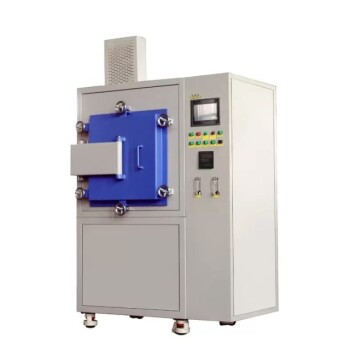At their core, muffle furnaces and drying ovens operate in entirely different thermal regimes. The primary difference is their maximum temperature capability: a muffle furnace can reach extreme temperatures up to 1500°C (2732°F), while a drying oven is designed for much lower temperatures, typically operating below 300°C (572°F).
The choice between a muffle furnace and a drying oven is not about which is "better," but which is designed for your specific thermal process. Ovens use heated air to remove moisture, while furnaces use intense radiant heat to fundamentally transform materials.
The Fundamental Divide: Purpose and Temperature
The vast difference in temperature capability stems from the distinct purpose for which each device is engineered.
Drying Ovens: Low-Temperature Moisture Removal
A drying oven is designed for processes like drying, sterilizing, and curing. Its main function is to remove moisture from a sample at relatively low temperatures.
They achieve this by circulating heated air. This convection process is efficient for removing water vapor and ensuring the sample is thoroughly dried.
Muffle Furnaces: High-Temperature Material Transformation
A muffle furnace is built for high-temperature applications like ashing, heat-treating metals, materials research, and gravimetric analysis. Its purpose is to alter the chemical or physical properties of a material through intense heat.
These applications require temperatures far beyond what a drying oven can produce, often exceeding 1000°C.
How Design Dictates Capability
The construction and heating method of each device are tailored to its specific temperature range and purpose. This is the "why" behind their different capabilities.
Heating Method and Atmosphere
Drying ovens continuously circulate fresh air across heating elements. This constant airflow is excellent for carrying away evaporated moisture but makes it impossible to control the atmospheric conditions inside.
Muffle furnaces, by contrast, use powerful electric heating elements to heat a sealed inner chamber, or "muffle." Heat is transferred primarily through radiation, not airflow. This sealed design allows for a highly stable and uniform thermal environment and enables the use of a controlled atmosphere, such as an inert gas, to prevent oxidation.
Insulation and Construction
To safely contain temperatures exceeding 1000°C, muffle furnaces are built with extremely heavy insulation and refractory ceramic materials. This robust construction is critical for both performance and operator safety.
Drying ovens operate at much lower, less demanding temperatures. Therefore, they are constructed with significantly less insulation and lighter-weight materials, making them less suited for extreme heat retention.
Heat Distribution and Uniformity
In a muffle furnace, the sealed chamber and radiant heating naturally create a highly uniform temperature throughout the interior. There is no forced air to create turbulence or uneven pockets of heat.
While convection ovens are designed to circulate air for uniformity, they can be prone to developing hot and cold spots, especially when fully loaded. This makes them less reliable for applications requiring precise temperature consistency across the entire sample.
Understanding the Trade-offs
Choosing the wrong instrument can lead to failed processes, damaged equipment, or unnecessary expense.
Cost and Complexity
Muffle furnaces are significantly more expensive than drying ovens. Their high-temperature capabilities demand specialized materials, advanced insulation, and more sophisticated temperature controllers.
Chamber Size and Throughput
Drying ovens are often available with much larger internal chambers than muffle furnaces. Their simpler construction allows for designs geared towards higher throughput for bulk drying or curing applications.
Process Limitations
The functions are not interchangeable. You cannot perform a high-temperature ashing process in a drying oven, as it simply cannot generate the required heat.
While you could technically dry a sample in a muffle furnace, it is highly inefficient and provides no mechanism to remove the evaporated moisture, which may remain trapped in the chamber.
Making the Right Choice for Your Process
Your decision must be guided by the specific thermal requirements of your application.
- If your primary focus is removing moisture, curing, or sterilizing below 300°C: A drying oven is the correct, cost-effective tool for the job.
- If your primary focus is ashing, heat-treating, materials analysis, or any process above 300°C: You must use a muffle furnace.
- If your primary focus is process integrity in a controlled atmosphere: The sealed chamber of a muffle furnace is your only option.
Ultimately, selecting the right equipment ensures the safety, efficiency, and success of your thermal processing work.
Summary Table:
| Feature | Muffle Furnace | Drying Oven |
|---|---|---|
| Max Temperature | Up to 1500°C | Up to 300°C |
| Primary Use | Material transformation (e.g., ashing, heat-treating) | Moisture removal (e.g., drying, sterilizing) |
| Heating Method | Radiant heat in sealed chamber | Convection with air circulation |
| Atmosphere Control | Yes (e.g., inert gas) | No |
| Temperature Uniformity | High | Can have hot/cold spots |
Struggling to choose the right high-temperature furnace for your lab? KINTEK specializes in advanced solutions like Muffle, Tube, Rotary, Vacuum & Atmosphere Furnaces, and CVD/PECVD Systems. With our strong R&D and in-house manufacturing, we offer deep customization to meet your unique experimental needs—ensuring precise temperature control and enhanced process efficiency. Contact us today to discuss how our tailored furnace solutions can elevate your thermal processing work!
Related Products
- 1400℃ Muffle Oven Furnace for Laboratory
- Laboratory Muffle Oven Furnace with Bottom Lifting
- 1700℃ High Temperature Muffle Oven Furnace for Laboratory
- 1800℃ High Temperature Muffle Oven Furnace for Laboratory
- Multi Zone Laboratory Quartz Tube Furnace Tubular Furnace
People Also Ask
- What precautions should be taken when placing items into the muffle furnace? Ensure Safety and Accuracy in High-Temp Operations
- How is the muffle furnace packaged for shipping? Ensuring Safe Delivery for Your Lab Equipment
- What safety features are typically included in a muffle furnace? Essential Systems for Operator and Equipment Protection
- What role does temperature control play in a muffle furnace? Unlock Precision and Reliability for Your Lab
- What are the key features of the muffle furnace's design? Discover Precision Heating and Safety



















